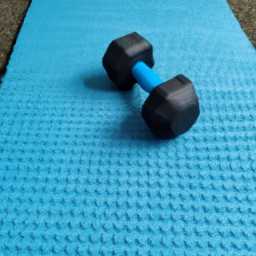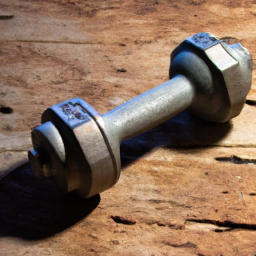In this article, you will learn how to incorporate resistance training into your workout routine to effectively build muscle. We will discuss the benefits of resistance training, different types of exercises you can do, and how to gradually increase the intensity over time. By the end of this article, you will have all the knowledge you need to start adding resistance training to your workouts and maximize your muscle growth. So let’s get started!
The Importance of Resistance Training
When it comes to building muscle, resistance training is essential. It not only helps to increase strength and power, but it also promotes muscle growth and improves overall functional fitness. Whether you’re looking to bulk up or simply improve your physique, incorporating resistance training into your workout routine is a must.
Understanding the Benefits of Resistance Training
Resistance training refers to any form of exercise that involves opposing a force or resistance to the muscles. This can be achieved through various methods such as weights, resistance bands, body weight exercises, or even household items like water bottles or cans. By subjecting the muscles to this external resistance, you create micro-tears in the muscle fibers, which then repair and grow stronger during rest and recovery.
One of the key benefits of resistance training is its ability to increase muscle mass. When you perform resistance exercises, you stimulate the muscle fibers, signaling your body to adapt and grow stronger. Over time, this leads to muscle hypertrophy, which not only improves your physical appearance but also increases your metabolism, making it easier to maintain a healthy weight.
Resistance training also helps to enhance overall strength and power. By challenging your muscles against a resistance, you improve their ability to generate force, which is crucial for everyday activities like lifting objects, climbing stairs, or participating in sports. Additionally, resistance training can improve bone density, joint stability, and posture, reducing the risk of injuries and enhancing overall functional fitness.
Why Resistance Training is Essential for Muscle Building
While cardiovascular exercise has its own benefits, solely relying on it for muscle building is not enough. Resistance training specifically targets the muscles and provides the stimulus needed for growth. It allows you to target specific muscle groups, ensuring balanced muscular development and symmetry. This is especially important for individuals looking to improve their aesthetics and create a well-proportioned physique.
Resistance training also provides the opportunity to progressively overload the muscles. This means gradually increasing the resistance or intensity of your exercises over time. By consistently challenging your muscles, you push them beyond their comfort zone, forcing them to adapt and grow stronger. This principle of progressive overload is crucial for continued muscle development.
In addition to building muscle, resistance training also helps to preserve lean muscle mass when combined with a calorie deficit. When you’re trying to lose weight, especially through dieting, there is a risk of losing muscle along with fat. However, by incorporating resistance training into your routine, you can signal your body to prioritize fat loss while maintaining your muscle mass.
Determining Your Training Goals
Before you start incorporating resistance training into your workout routine, it’s important to determine your specific training goals. This will help you design a program that is tailored to your needs and preferences.
Identifying Your Muscle Building Objectives
Ask yourself what you hope to achieve through resistance training. Are you looking to gain overall muscle mass, or do you have specific muscle groups that you want to target? Are you aiming for a lean and toned physique or a more bulked-up appearance? Identifying your specific goals will allow you to focus your efforts and choose the most effective exercises for your desired outcome.
Setting Realistic and Achievable Goals
It’s important to set realistic and achievable goals when it comes to resistance training. Building muscle takes time and consistency, and it’s unrealistic to expect significant changes overnight. Set small, measurable goals that you can work towards and celebrate your progress along the way. This will help to keep you motivated and engaged with your training program.
Choosing the Right Resistance Training Exercises
Once you have identified your training goals, it’s time to choose the right resistance training exercises. There are various types of resistance exercises to choose from, and selecting the ones that align with your goals and fitness level is crucial.
Understanding Different Types of Resistance Exercises
Resistance exercises can be categorized into two main types: compound and isolation exercises. Compound exercises involve multiple muscle groups and joints, making them highly efficient for overall muscle development. Examples of compound exercises include squats, deadlifts, bench press, and overhead press.
Isolation exercises, on the other hand, target specific muscle groups, allowing you to focus on strengthening and shaping those areas. Examples of isolation exercises include bicep curls, tricep extensions, and calf raises.
Both types of exercises have their own benefits, and incorporating a combination of compound and isolation exercises into your training program is recommended for balanced muscle development.
Selecting Exercises that Target Multiple Muscle Groups
When choosing resistance exercises, it’s important to select ones that target multiple muscle groups. This ensures that you are maximizing your time and effort, as well as promoting balanced muscle development. Compound exercises like squats and deadlifts engage multiple muscle groups, including the legs, glutes, core, and back. By incorporating these exercises into your routine, you can effectively work multiple muscles in a single movement.
Evaluating Exercises based on Your Fitness Level
It’s essential to consider your fitness level when selecting resistance exercises. If you’re a beginner, start with exercises that are suitable for your current strength and mobility. Bodyweight exercises like push-ups, squats, and lunges are great options for beginners as they allow you to focus on proper form and technique while building a solid foundation of strength.
As you progress, you can gradually introduce more challenging exercises and incorporate weights or resistance bands to increase the resistance. However, it’s important to listen to your body and avoid pushing yourself too hard, as this can lead to injury. Always start with lighter weights and gradually increase the intensity as you become more comfortable and confident with the exercises.
Designing Your Resistance Training Program
Once you have chosen the right exercises, it’s time to design your resistance training program. This involves creating a structured workout schedule, determining the right frequency and duration, choosing the appropriate resistance and repetitions, and considering rest and recovery.
Creating a Structured Workout Schedule
To effectively incorporate resistance training into your workout routine, it’s important to establish a structured schedule. Determine how many days per week you can commit to resistance training and allocate specific days for this type of exercise. This will help you stay on track and ensure that you are consistently providing the stimulus needed for muscle growth.
Determining the Right Frequency and Duration
The frequency and duration of your resistance training sessions will depend on your goals and fitness level. As a general guideline, aim for at least two to three resistance training sessions per week. This will allow sufficient time for rest and recovery while providing enough stimulus for muscle growth.
The duration of each workout session can vary depending on the exercises you choose and the number of sets and repetitions performed. A typical resistance training session can range from 45 minutes to an hour, including warm-up and cool-down periods. However, it’s important to listen to your body and avoid overtraining. If you start feeling excessively fatigued or experience prolonged muscle soreness, consider reducing the duration or intensity of your workouts.
Choosing the Appropriate Resistance and Repetitions
Selecting the appropriate resistance and repetitions for each exercise is crucial for muscle building. The resistance refers to the amount of weight or intensity used, while repetitions refer to the number of times an exercise is performed consecutively.
For muscle building, it’s recommended to choose a resistance that allows you to perform eight to twelve repetitions with good form and technique. This range is known as the hypertrophy range and is optimal for stimulating muscle growth. As you become stronger, you can gradually increase the resistance to continue challenging your muscles and promoting further development.
Considering Rest and Recovery
Rest and recovery are just as important as the actual exercise when it comes to muscle building. During resistance training, you create micro-tears in the muscle fibers, and it’s during rest and recovery that they repair and grow stronger. Therefore, it’s important to include rest days in your training program to allow your muscles enough time to recover.
The amount of rest needed will vary depending on your fitness level and the intensity of your workouts. As a general guideline, aim for at least one to two rest days per week. This doesn’t mean you have to be completely sedentary on those days; you can engage in active recovery activities like yoga, stretching, or light cardiovascular exercise to keep your body moving without placing excessive stress on your muscles.
Proper Form and Technique
When performing resistance exercises, proper form and technique are essential to maximize results and minimize the risk of injury. It’s important to focus on quality over quantity and prioritize good form over heavy weights.
Understanding the Importance of Proper Form
Proper form ensures that you are targeting the intended muscle groups and minimizing stress on your joints and connective tissues. It also helps to maintain stability and balance, reducing the risk of injuries. Performing exercises with incorrect form not only decreases the effectiveness of the exercise but can also lead to muscle imbalances, strain, or sprains.
Learning the Correct Techniques for Each Exercise
To maintain proper form and technique, it’s important to learn the correct techniques for each exercise. This can be done through various resources such as fitness videos, online tutorials, or by seeking guidance from a qualified personal trainer. Take the time to practice and master the movements before progressing to heavier weights or more challenging variations.
Avoiding Common Mistakes and Injuries
Common mistakes during resistance training include using momentum instead of muscle control, lifting too heavy weights before properly mastering the exercise, and neglecting the use of proper breathing techniques. These mistakes can not only decrease the effectiveness of the exercise but also increase the risk of injuries.
To avoid these mistakes, always start with lighter weights to focus on proper form and control. Gradually increase the resistance as you become more comfortable with the exercise. Remember to breathe properly, exhaling during the exertion phase and inhaling during the relaxation phase. If you’re unsure about your technique, seek guidance from a qualified professional to ensure you’re performing the exercises correctly.
Progressive Overload and Adaptation
To continue making progress in your resistance training journey, it’s important to understand the principle of progressive overload and implement it into your routine.
Understanding the Principle of Progressive Overload
Progressive overload refers to the gradual increase in resistance, intensity, or volume over time to continually challenge the muscles. By consistently providing a stimulus that is slightly more challenging than what your muscles are used to, you force them to adapt and grow stronger. This is crucial for continued muscle development and prevents plateaus or stagnation in your progress.
Implementing Progressive Overload in Your Routine
There are various ways to implement progressive overload in your resistance training routine. You can gradually increase the resistance by adding more weight, using resistance bands with higher levels of tension, or increasing the difficulty of bodyweight exercises. You can also increase the number of sets or repetitions performed, reduce rest time between sets, or incorporate techniques like drop sets or supersets.
When implementing progressive overload, it’s important to do so gradually and listen to your body. Avoid making sudden, drastic changes as this can lead to injuries or burnout. Aim to increase the intensity or volume of your training program by about 5-10% every few weeks and monitor how your body responds.
Allowing Sufficient Time for Adaptation
While it’s important to challenge your muscles through progressive overload, it’s equally important to allow sufficient time for adaptation and recovery. This means incorporating rest days into your training program and paying attention to your body’s signals.
If you find that you’re consistently fatigued, experiencing prolonged muscle soreness, or not making any progress despite increasing the resistance or intensity, it may be a sign that you need to scale back and allow more time for recovery. Remember, muscle growth happens during rest and recovery, so it’s important to strike a balance between challenging your muscles and providing them with enough time to repair and grow stronger.
Integrating Resistance Training with Other Workouts
While resistance training is crucial for muscle building, it’s important to strike a balance and integrate it with other types of workouts for optimal results.
Combining Resistance Training with Cardiovascular Exercises
Cardiovascular exercise, often referred to as cardio, plays an important role in overall fitness and can complement your resistance training routine. Cardio exercises like running, swimming, or cycling improve heart health, enhance endurance, and burn calories. By incorporating cardio into your routine, you can improve your cardiovascular fitness while promoting fat loss and maintaining muscle mass.
To strike a balance between resistance training and cardio, aim for three to five cardio sessions per week, each lasting about 30-60 minutes, depending on your fitness level and goals. You can perform cardio exercises on separate days from your resistance workouts or combine them within the same session. If combining, it’s best to prioritize your resistance training exercises to maintain energy and focus.
Incorporating Flexibility and Mobility Training
Flexibility and mobility training should also be incorporated into your workout routine to improve joint range of motion, posture, and prevent injuries. Exercises like stretching, yoga, or Pilates can help increase flexibility and enhance overall mobility.
Including stretching exercises as part of your warm-up and cool-down routine can prepare your muscles for the resistance exercises and prevent muscle imbalances or tightness. Performing yoga or Pilates sessions on rest days can also help to relax and stretch your muscles, aiding in recovery and reducing muscle soreness.
Balancing Different Types of Workouts for Optimal Results
To achieve optimal results, it’s important to strike a balance between resistance training, cardiovascular exercises, and flexibility training. Designing a well-rounded workout routine that includes all three components will not only promote muscle building but also enhance overall fitness, mobility, and well-being.
Remember, everyone’s goals and preferences are different, so it’s important to find a balance that works best for you. Listen to your body, pay attention to how you feel after each workout, and make adjustments accordingly. What works for one person may not work for another, so don’t be afraid to experiment and find what combination of workouts brings you joy and produces the desired results.
Monitoring and Adjusting Your Training
To ensure progress and avoid plateaus, it’s important to monitor your training and make necessary adjustments and modifications when needed.
Tracking Your Progress and Performance
Track your progress and performance during your resistance training journey. Keep a workout log to record the exercises you perform, the weights or resistance used, the number of sets and repetitions, and any notes or reflections on each session. This will allow you to see your progress over time, identify patterns, and make adjustments accordingly.
In addition to tracking your workouts, also pay attention to how your body responds to the training. Listen to the cues it gives you, such as excessive fatigue, increased muscle soreness, or lack of progress. These signals may indicate the need for adjustments in your program, such as reducing the intensity, increasing rest days, or modifying your exercises.
Making Necessary Adjustments and Modifications
As you progress in your training, it’s important to periodically assess and make necessary adjustments to your routine. This can include increasing the resistance or intensity, changing the exercises or their variations, or modifying the training volume or frequency. By regularly challenging your muscles in new ways, you can prevent plateaus, keep your workouts fresh and engaging, and continue making progress towards your goals.
Remember, consistency is key when it comes to resistance training, but that doesn’t mean you have to stick to the same routine forever. It’s important to listen to your body, adapt as needed, and find ways to keep your training enjoyable and sustainable.
Seeking Professional Guidance if Needed
If you’re new to resistance training or feel unsure about designing your own program, seeking professional guidance can be beneficial. A qualified personal trainer or strength and conditioning specialist can assess your current fitness level, help you identify your goals, and design a tailored training program that aligns with your needs and preferences. They can also provide guidance on proper form and technique, help with exercise selection, and provide ongoing support and accountability.
Nutrition and Recovery for Muscle Building
While resistance training is crucial for muscle building, nutrition and recovery are equally important factors to consider.
Understanding the Role of Nutrition in Muscle Building
Nutrition plays a vital role in muscle building. To effectively build and repair muscle tissue, your body needs an adequate amount of protein, which is the building block of muscle. Aim to consume around 0.7-1 gram of protein per pound of body weight per day from sources such as lean meats, poultry, fish, eggs, dairy, legumes, and plant-based protein sources.
In addition to protein, it’s important to consume a well-balanced diet that includes carbohydrates for energy and fuel, healthy fats for hormone production and overall health, and a variety of fruits and vegetables for essential vitamins, minerals, and antioxidants. Hydration is also crucial for muscle function and recovery, so aim to drink plenty of water throughout the day.
Eating a Balanced Diet for Muscle Recovery and Growth
To support muscle recovery and growth, it’s important to provide your body with the necessary nutrients. Consuming a balanced post-workout meal or snack that includes protein and carbohydrates within 30-60 minutes after your workout can help replenish glycogen stores, repair damaged muscles, and kickstart the recovery process.
Examples of post-workout meals or snacks include a protein shake with fruit, chicken or turkey with sweet potatoes, Greek yogurt with berries, or a veggie omelet with whole-grain toast. Experiment with different options and find what works best for your body and preferences.
Incorporating Proper Post-Workout Nutrition
In addition to focusing on post-workout nutrition, pay attention to your overall daily nutrition and ensure you’re consuming enough calories to support muscle growth. Depending on your goals and activity level, you may need to adjust your calorie intake accordingly. Be mindful of portion sizes, choose nutrient-dense foods, and aim for consistency in your eating habits.
In addition to proper nutrition, it’s important to prioritize sleep and rest. During sleep, your body undergoes important recovery processes, such as muscle repair and hormone production. Aim for seven to nine hours of quality sleep each night to support muscle growth and overall well-being.
Conclusion
Incorporating resistance training into your workout routine is essential for muscle building and overall fitness. By understanding the benefits of resistance training, determining your training goals, choosing the right exercises, designing a structured program, maintaining proper form, implementing progressive overload, integrating different types of workouts, monitoring and adjusting your training, and focusing on nutrition and recovery, you can successfully add resistance training to your routine and achieve your muscle building objectives.
Remember, building muscle takes time, consistency, and patience. Enjoy the process, celebrate your progress, and stay committed to your goals. With the right mindset, effort, and knowledge, you can transform your physique and improve your overall quality of life. Start incorporating resistance training today and reap the numerous benefits it has to offer. Good luck!





